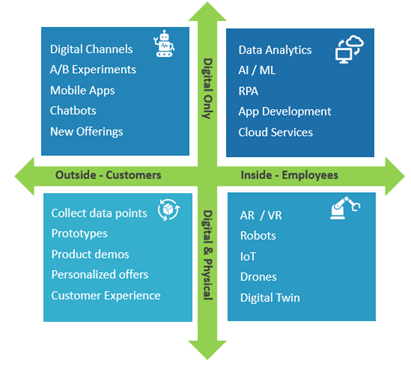Innovation is paramount for business growth and survival in the digital economy. But how do organizations initiate and mature digital innovation as a competency? What enablers and practices are needed for rapid experimentation and innovation culture?
These were the questions daunting me before I started my executive education journey at MIT Sloan Executive Education. Three years ago, I started attending executive courses. Initially I pursued the Executive Certificate in Management and Leadership. However, after completing the certificate, I couldn't help but continue my quest for more MIT education. Fast forward three years, and now I am extremely proud to say that I completed more than a dozen courses and earned the Advanced Certificate for Executives in Management, Innovation, and Technology (ACE) from MIT Sloan.
My learnings from these outstanding courses on digital strategies, analytics, artificial intelligence, IoT, innovation, and enterprise wide-transformation motivated me to create a framework for digital innovation.
The Importance of a Digital Innovation Culture
Innovation is about exploring ideas, conducting experiments, validating the hypothesis, and checking the feasibility of creating or enhancing value for customers. Traditionally, innovation experiments are limited to R&D and mainly inside the organization within the purview of subject matter experts and dedicated teams. Additionally, some organizations actively engage external partners such as universities, startups, and other organizations to explore innovative ideas.
To stay competitive in the digital era, however, companies can't operate within the same old boundaries. Today's businesses are under immense pressure to innovate and remain relevant in the face of constant digital transformation. Disruptions to the incumbents may come in any form and shape. Disruptions can happen rapidly with digital technologies such as cloud services, artificial intelligence, machine learning, data analytics, automation, IoT, Edge, 5G, and Blockchain. Startups can experiment with new business models and scale up quickly. In addition, other market players may challenge your organization's competitive position with their innovation and agile practices.
To stay successful in the digital world, businesses must establish digital innovation capabilities to leverage digital technologies and experiment with new ideas, strategies, and processes. The organizations that can create this digital innovation culture will be able to take advantage of the opportunities created by the digital transformation to sustain and grow their businesses.
The Need for Rapid Experimentation
Often, digital leaders fail to establish an innovation culture because they are too focused on the digital transformation agenda, and not enough time is spent creating an environment where employees feel comfortable taking risks, trying new ideas, and being creative. In order to make innovation a habit, the organization needs to create an environment that fosters experimentation, learns from failures, and moves on quickly.
Understanding the changes in customer needs and behaviors, testing the new business models quickly, and responding to those changes are becoming key for businesses. Rapid experimentation as the center of digital innovation facilitates this agility for organizations. Rapid experimentation is not just about generating new ideas but also about validating them quickly and then either moving forward or closing it down fast if it doesn't work out as expected.
DevOps and Agile have become normal in product development and software engineering. Digital experimentations must also adopt similar practices with shorter sprint cycles, customer-centric, design thinking, minimum viable products, and leveraging digital technologies.
Four Groups of Digital Experimentation
After understanding the need for rapid experimentation in digital innovation, the next question is how do we generate ideas for experimentation, and from where do we start?
Let us review some experiments based on whether they can be entirely conducted by digital means alone or need physical aspects also. Another dimension of experiments is who are they targeted for—employees or customers. Outcomes of experiments may help employees improve their experience or skills to create value for the organization or help customers consume new valued products or services.
Below, we can review some digital experimentation ideas for all the dimensions mentioned above, separating them into four groups.

Group 1 – Digital for Employees
These are experiments with only digital means for employees without any need for physical interactions. These experiments can be less time consuming compared to other groups of experiments. Outcomes of these experiments can augment employee tasks with additional insights and automation and provide necessary tools to improve the effectiveness of their job with possibilities for more creative work. Here are some examples:
- Data analytics – Explore data with visualizations and advanced analytics for insights needed for a data-driven operating model.
- Artificial Intelligence / Machine Learning (AI / ML) - Machine learning experiments with structured data and experiments with unstructured data such as images, video, and text.
- Robotic Process Automation (RPA) – Automate processes to eliminate repetitive manual work and to free up humans for more creative work.
- App development – Develop apps with simple low code or no-code platforms and integrate multiple applications with APIs and create required workflows.
- Cloud services – Leverage cloud infrastructure services to span a virtual machine, host a website, use data repository, create an application, or run data models.
Group 2 – Digital and Physical for Employees
Experiments in this group will help employees to create or use digitally embedded products. Outcomes of these experiments can be building physical prototypes, exploring the feasibility of new use cases, or experimenting with new solutions to provide a revived business model. Here are some examples:
- AR / VR – Augmented and virtual realities can be used to enhance employees' creativity, on-the-job training, and collaboration.
- Robots – Physical robots can act as human assistants or function as a new workforce in value creation.
- Drones - Flying drones can be used for inspection and payload deliveries.
- 3D Printing – Additive printing helps build prototypes and create models.
- IoT – Sensors attached to devices or placed in locations along with edge computing can give new possibilities for the connected world.
- Digital Twin - For manufacturing and heavy machinery companies, developing a digital twin helps maximize utilization and risk management.
Group 3 – Digital for customers
Experiments in this group need customer involvement to try new offerings or engage in new channels. These experiments may take longer than experiments with employees as we have to approach customers to participate. Outcomes of this group can be learnings from customer behavior, engaging with new channels, or reaching new customer segments. Here are some examples:
- Customer journey – Identify and eliminate friction from the customer journey in path to purchase and product experience.
- Digital Channels – Develop existing channels or create new channels of engagement such as chatbots, new website, mobile apps, and social media
- A/B Testing – Experimental A/B testing to identify customer behavioral patterns, click-through rates, or increase sales funnel conversion rates.
- Personalized offerings – Try out personalized offerings or products or services to cross-sell or upsell.
- Ask customers – Invite customers to participate in surveys to provide feedback and share any unmet needs or wish lists.
Group 4 – Digital and Physical for Customers
There is nothing rapid here; when we talk about customer interactions in the physical world, it takes significant time and resources to try out any experiment. But, despite that, the experiments in this group can be incredibly beneficial for digital innovations for an organization that has physical channels or physical products or stores.
- Capture Data points - Digital technologies can be used to capture customer behavior by observing and analyzing facial expressions, footprints in store, thermal scans and tone variations.
- Prototypes – Offer a prototype of a physical product with digital features to customers either to seek direct feedback or capture customer interactions with the product.
- Product Demos – Provide immense experience of products with augmented reality or interactive information with digital panels wherever applicable.
- Personalized Offers – Experiments with personalized offers using geolocation, in-store mobile phone notifications, customized alerts at the checkout counter and mails to the house.
- Customer experience - Reduce friction at any physical touchpoint of a customer journey, either supplementing with digital service or capturing more info to enhance customer experience.
Conclusion
Timing is perfect for digital experimentation, better than ever before, with the availability of digital tools, open-source projects, and easy-to-use services from cloud providers, including machine learning, automation, low code applications development, easy integration with a variety of applications, and available datasets.
Not knowing about these possibilities is no longer an excuse for not innovating. No matter your industry, your company can conduct digital experiments, and these innovation efforts may even turn into transformational initiatives for your business. The final thought I want to emphasize is that with digital innovation efforts, the downside is capped—the money spent on the resources—but the upside potential is unlimited.
Author Bio

Raj Polanki is a divisional CIO at Wacker Chemical Corporation. He has 25 years of experience in progressive and influential leadership positions at global companies. He is also an author, speaker, and recognized thought leader. He is passionate about helping future technology leaders through Future CIO Club. Polanki earned an MBA from Ross Business School at University of Michigan and an Advanced Certificate for Executives in Management, Innovation, and Technology (ACE) from MIT Sloan.








